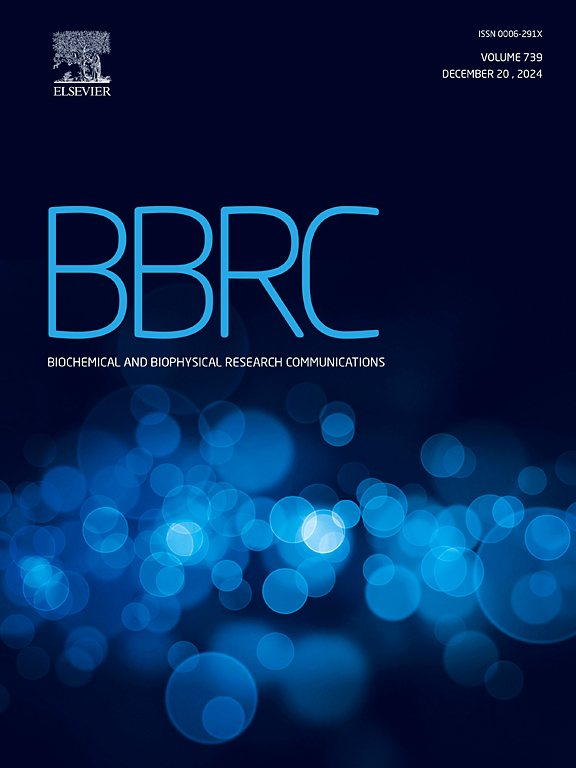A stable rat model of high altitude pulmonary edema established by hypobaric hypoxia combined diurnal temperature fluctuation and exercise
IF 2.5
3区 生物学
Q3 BIOCHEMISTRY & MOLECULAR BIOLOGY
Biochemical and biophysical research communications
Pub Date : 2025-01-01
DOI:10.1016/j.bbrc.2024.151193
引用次数: 0
Abstract
Hypobaric hypoxia (HH) is regarded as the main cause of high-altitude pulmonary edema (HAPE), however, the effect of diurnal temperature fluctuation and exercise has been overlooked. The aim of current study was to elucidate the role of diurnal temperature fluctuation and exercise in the development of HAPE and establish a reliable experimental rat model. Male SPF Wistar rats were assigned to control group (1400 m, 25 °C) and five model groups: Model Ⅰ group (6000 m, 25 °C), Model Ⅱ group (6000 m, 2 °C), Model Ⅲ group (6000 m, 12 °C/2 °C light/dark cycle), Model IV group (6000 m, 2 °C, and exercise) and Model V group (6000 m, 12 °C/2 °C light/dark cycle, and exercise). After exposure for 72 h, the blood and lung tissues were collected for further research. The rats in Model I group did not show signs of HAPE. Compared with Model I group, the rats in Model II and Model III groups were suffered from more damage, evidence by enhanced oxidative stress and inflammatory reaction, but still did not show signs of HAPE. Model IV and Model V could induce HAPE, display the obvious pathological changes and edema, more serious oxidative stress and inflammatory reaction in lung tissues, suggesting that the key role of exercise in the development of HAPE. The rats in the Model V group showed the best performance in terms of modeling indicators, indicating that diurnal temperature fluctuation could further aggravate the degree of lung edema. In summary, HH combined with diurnal temperature fluctuation and exercise is a stable and reliable modeling method for HAPE, which can be used for subsequent research on the prevention and treatment of HAPE.

低气压缺氧联合昼夜体温波动和运动建立稳定的大鼠高原肺水肿模型。
低气压缺氧(HH)被认为是引起高原肺水肿(HAPE)的主要原因,但昼夜温度波动和运动的影响一直被忽视。本研究旨在阐明昼夜温度波动和运动在HAPE发生发展中的作用,建立可靠的实验大鼠模型。将雄性SPF Wistar大鼠分为对照组(1400 m, 25°C)和5个模型组:模型Ⅰ组(6000 m, 25°C)、模型Ⅱ组(6000 m, 2°C)、模型Ⅲ组(6000 m, 12°C/2°C明暗循环)、模型IV组(6000 m, 2°C,运动)和模型V组(6000 m, 12°C/2°C明暗循环,运动)。暴露72h后,采集血液和肺组织作进一步研究。模型1组大鼠未见HAPE症状。与模型1组比较,模型2和模型3组大鼠损伤加重,表现为氧化应激和炎症反应增强,但仍未出现HAPE的迹象。模型IV和模型V均可诱发HAPE,表现出明显的病理改变和水肿,肺组织氧化应激和炎症反应更为严重,提示运动在HAPE的发生发展中起关键作用。模型V组大鼠在造模指标上表现最好,说明昼夜温度波动会进一步加重肺水肿程度。综上所述,HH结合昼夜温度波动和运动是一种稳定可靠的HAPE建模方法,可用于后续HAPE的防治研究。
本文章由计算机程序翻译,如有差异,请以英文原文为准。
求助全文
约1分钟内获得全文
求助全文
来源期刊
CiteScore
6.10
自引率
0.00%
发文量
1400
审稿时长
14 days
期刊介绍:
Biochemical and Biophysical Research Communications is the premier international journal devoted to the very rapid dissemination of timely and significant experimental results in diverse fields of biological research. The development of the "Breakthroughs and Views" section brings the minireview format to the journal, and issues often contain collections of special interest manuscripts. BBRC is published weekly (52 issues/year).Research Areas now include: Biochemistry; biophysics; cell biology; developmental biology; immunology
; molecular biology; neurobiology; plant biology and proteomics

 求助内容:
求助内容: 应助结果提醒方式:
应助结果提醒方式:


